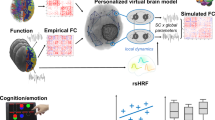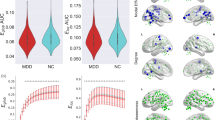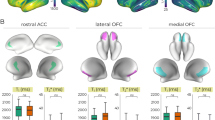Abstract
The primary objective of our study was to examine the role of atrophy, high intensity lesions and medical comorbidity in the pathophysiology of major depressive disorder in the elderly (late-life MDD). Our sample was comprised of 51 patients with late-life MDD and 30 non-depressed controls. All subjects were scanned on 1.5 tesla magnetic resonance imaging scanner (MRI) and absolute and normalized measures of brain and lesion volumes were obtained and used for comparison between groups. Patients with MDD had significantly smaller frontal lobe volumes, together with larger whole brain lesion volumes when compared with controls (p < .05). Whole brain lesion volumes correlated significantly (r = 0.41, p = .006) with overall medical comorbidity. The odds ratio (OR) for existing MDD increases significantly with a decrease in frontal lobe volume and an increase in whole brain lesion volumes (p < .05). Our findings suggest that atrophy and high intensity lesions represent relatively independent pathways to late-life MDD. While medical disorders lead to neuropathological changes that are captured on MR imaging as high intensity signals, atrophy may represent a relatively autonomous phenomenon. These findings have broad implications for the pathophysiology of mood disorders and suggest that complementary neurobiological processes may lead to cumulative neuronal injury thereby predisposing to clinical depression.
Similar content being viewed by others
Log in or create a free account to read this content
Gain free access to this article, as well as selected content from this journal and more on nature.com
or
References
Alexopolous G, Young RC, Meyers BS . (1988): Late-onset depression. Psychiatry Clin North Am 11: 101–105
Alexopolous GS, Meyers BS, Young RC, Kakuma T, Silbersweig D, Charlson M . (1997): Clinically defined vascular depression. Am J Psychiatry 154: 562–565
American Heart Association. (1990): Stroke risk factor prediction chart. Dallas, American Heart Association
American Psychiatric Association. (1994): Diagnostic and statistical manual of mental disorders, 4th ed. Washington, DC, American Psychiatric Press
Baxter LR, Phelps ME, Mazziotta JC, Guze BH, Schwartz JM, Selin CE . (1987): Local cerebral glucose metabolic rates in obsessive-compulsive disorder. Arch Gen Psychiatry 44: 211–218
Beck DA, Koenig HG . (1996): Minor Depression: a review of the Literature. International J Psychiatry in Medicine 26: 177–209
Berkman LF, Berkman CS, Kasl S, Freeman DH, Leo L, Ostfeld AM, Cornonti-Huntley J, Brody JA . (1986): Depressive symptoms in relation to physical health and functioning in the elderly. American Journal of Epidemiology 124: 372–388
Blazer DG, Hughes DC, George LK . (1987): The epidemiology of depression in an elderly community population. Gerontologist 27: 281–287
Blazer DG . (1989): Depression in the elderly. N Eng J Med 320: 164–166
Blazer DG . (1994): Dysthymia in community and clinical samples (editorial). Am J Psychiatry 151: 1567–1569
Boyko OB, Alston SR, Fuller GN . (1994): Utility of postmortem magnetic resonance imaging in clinical neuropathology. Arch Pathol Lab Med 118: 219–225
Caine ED, Lyness JM, King DA . (1993): Reconsidering depression in the elderly. Am J Geriatr Psychiatry 1: 4–20
Coffey CE, Figiel GS, Djang WT . (1990): Subcortical hyperintensity on magnetic resonance imaging: a comparison of normal and depressed elderly subjects. Am J Psychiatry 147: 187–189
Coffey CE, Wilkinson WE, Weiner ARD . (1993): Quantitative cerebral anatomy in depression: a controlled magnetic resonance imaging study. Arch Gen Psychiatry 50: 7–16
Cowell PC, Turetsky BI, Gur RC, Grossman RI, Shtasel DL, Gur RE . (1994): Sex differences in aging of the human frontal and temporal lobes. J Neurosci 14: 4748–4755
DeReuck J, Crevits L, De Coster W . (1980): Pathogenesis of Biswanger's chronic subcortical encephalopathy. Neurology 30: 920–928
Drayer B . (1988): Imaging of the aging brain (normal findings and pathologic conditions). Radiology 166: 785–806
Duman RS, Heninger GR, Nestler EJ . (1997): A molecular and cellular theory of depression. Arch Gen Psychiatry 54: 597–606
Fisher MC . (1989): Biswanger's encephalopathy: a review. J Neurol 236: 65–79
Folstein MF, Folstein SE, McHugh PR . (1975): Mini-mental state: a practical method for grading the cognitive state of patients for the clinician. J Psychiatry Res 12: 189–198
Frasure-Smith N, Lesperance F, Talajic M . (1995): Depression and 18-month prognosis after myocardial infarction. Circulation 91: 999–1005
Fuster JM . (1989): The prefrontal cortex: anatomy, physiology, and neuropsychology of the frontal lobe. New York, Raven Press.
Fuster JM . (1996): Frontal Lobe Syndromes. In Fogel BS, Schiffer RB, Rao SM, (eds), Neuropsychiatry. Baltimore, Williams and Wilkins, pp 407–413
Gierz M, Jeste DV . (1993): Physical comorbidity in elderly schizophrenic and depressed patients. American Journal of Geriatric Psychiatry 1: 165–170
Glassman AH, Shapiro PA . (1998): Depression in the course of coronary artery disease. American Journal of Psychiatry 155: 4–11
Greenwald BS, Kramer-Ginsberg E, Krishnan KRR . (1996): MRI signal hyperintensities in geriatric depression. Am J Psychiatry 153: 1212–1215
Hamilton M . (1967): Development of a rating scale for primary depressive illness. British Journal of Social and Clinical Psychology 6: 278–296
Hastak SM, Hachinski VC . (1992): Multi-infarct dementia: an expanding concept. In Barnett HJM, Mohr JP, Stein BM, Yatsu FM, eds. Stroke: pathophysiology, diagnosis, and management, 2nd ed. New York, Churchill-Livingstone, pp. 793–803
Huang K, Wu L, Luo Y . (1985): Biswanger's disease: progressive subcortical encephalopathy or multi-infarct dementia? Can J Neurol Sci 12: 88–94
Jeste DV, Lohr JB, Goodwin FK . (1988): Neuroanatomical studies of major affective disorders: a review and suggestions for further research. Br J Psychiatry 153: 444–459
Katz IR, Streim J, Parmalee P . (1994): Psychiatric-medical comorbidity: implications for health services delivery and for research on depression (editorial). Biol Psychiatry 36: 141–145
Katz IR . (1996): On the inseparability of mental and physical health in aged persons: lessons from depression and medical comorbidity. Am J Geriatr Psychiatry 4: 1–16
Koenig HG, O′Connor CM, Guarisco SA . (1993): Depressive disorder in older medical inpatients on general medical and cardiology services at a university teaching hospital. Am J Ger Psychiatry 3: 197–210
Kohn MI, Tanna NK, Herman GT . (1991): Analysis of brain and cerebrospinal fluid volumes with MR imaging. Radiology 178: 115–122
Krishnan KRR, Goli V, Ellinwood EH . (1988): Leukoencephalopathy in patients diagnosed as major depressive. Biol Psychiatry 23: 519–522
Krishnan KRR . (1993): Neuroanatomical substrates of depression in late life. J Geriatric Psychiatry Neurol 6: 39–58
Krishnan KRR, Hays JC, Blazer DG . (1997): MRI-defined vascular depression. Am J Psychiatry 154: 497–501
Kumar A, Gottlieb G . (1993): Frontotemporal dementias: a new clinical syndrome? The Am J Ger Psychiatry 1: 95–108
Kumar A, Newberg A, Alavi A . (1993): Regional cerebral glucose metabolism in late-life depression and Alzheimer's disease. Proc Natl Acad Sci U S A 90: 7019–7023
Kumar A, Newberg A, Alavi A . (1994): MRI volumetric studies in Alzheimer's disease: relationship to clinical and neuropsychological variables. Am J Ger Psychiatry 2: 21–31
Kumar A, Miller D, Ewbank D, Yousem D, Newberg A, Samuels S, Cowell P, Gottlieb G . (1997a): Quantitative neuroanatomic measures and comorbid medical illness in late life depression. Am J Ger Psychiatry 5: 15–25
Kumar A, Schweizer E, Zhisong J, Miller D, Bilker W, Swan L . et al (1997b): Neuroanatomical substrates of late-life minor depression. Archives of Neurology 54: 613–617
Kumar A, Zhisong J, Bilker W, Udupa J, Gottlieb G . (1998): Late-onset minor and major depression: early evidence of common neuroanatomical substrates detected using MRI. Proc Natl Acad Sci 95: 7654–7658
Lacro JP, Jeste DV . (1994): Physical comorbidity and polypharmacy in older psychiatric patients. Biol Psychiatry 36: 146–152
Lesser IM, Mena I, Boone KB . (1994): Reduction of cerebral blood flow in older depressed patients. Arch Gen Psychiatry 51: 677–686
Linn BS, Linn MW, Gural L . (1968): Cumulative illness rating scale. J Am Geriatr Soc 16: 622–626
Loizou LA, Kendall BE, Marshall J . (1981): Subcortical arteriosclerotic encephalopathy: a clinical and radiologic investigation. J Neurol Neurosurg Psychiatry 44: 294–304
Longstreth WT, Manolio TA, Arnold A, Burke GL, Bryan N, Jungreis CA, Enright DL, O′Leary D, Fried L . (1996): Clinical correlates of white matter findings on cranial magnetic resonance imaging of 3301 elderly people: the cardiovascular health study. Stroke 27: 1274–1282
Lyness JM, Caine ED, Cox C . (1998): Cerebrovascular risk factors and later-life major depression: testing a small-vessel brain disease model. Am J Ger Psychiatry 6: 5–13
Mishkin M . (1964): Preservation of central sets after frontal lesions in monkeys. In Warren JM, Akert K, editors. The frontal granular cortex and behavior. New York, McGraw-Hill, pp 219–241
Morris P, Rapoport SI . (1990): Neuroimaging and affective disorders in late life: a review. Can J Psychiatry 35: 347–3549
NIH Consensus Development Panel on Depression in Late Life: diagnosis and treatment of depression in late life. (1992): JAMA 268: 1018–1024
Oxman TE, Barrett JE, Barrett J, Gerber P . (1987): Psychiatric symptoms in the elderly in a primary care practice. Gen Hosp Psychiatry 9: 167–173
Parmalee PA, Katz IR, Lawton MP . (1989): Depression in institutionalized aged: assessment and prevalence. J Gerontol 44: M22–M29
Rabins PV, Harvis K, Koven S . (1985): High fatality rates of late-life depression associated with cardiovascular disease. J Affective Disorders 9: 165–167
Rabins PV, Pearlson GD, Aylward E . (1991): Cortical magnetic resonance imaging changes in elderly inpatients with major depression. Am J Psychiatry 148: 617–620
Robinson RG, Kubos KL, Starr LB, Rao K, Price TR . (1984): Mood disorders in stroke patients. Brain 107: 81–93
Rodin G, Voshart K . (1986): Depression in the medically ill: an overview. Am J Psychiatry 143: 696–705
Ruegg RG, Zisook S, Swerdlow NR . (1988): Depression in the aged: an overview. Psychiatry Clin North Am 11: 83–99
Sackheim HA, Prohovnik I, Moeller R . (1993): Regional cerebral blood flow in mood disorders, II: comparison of major depression and Alzheimer's disease. J Nucl Med 34: 1090–1101
Sapolsky RM, Pulsinelli WA . (1985): Glucocorticoids potentiate ischemic injury to neurons: therapeutic implications. Science 229: 1397–1400
Sapolsky RM, Krey LC, McEwen BS . (1986): The neuroendocrinology of stress and aging: the glucocorticoid cascade hypothesis. Endocrine Reviews 7: 284–301
Sapolsky RM, Uno H, Rebert CS . (1990): Hippocampal damage associated with prolonged glucocorticoid exposure in primates. J Neurosci 10: 2897–2902
Schmidt R, Fazekas F, Offenbacher H . (1991): Magnetic resonance imaging white matter lesions and cognitive impairment in hypertensive individuals. Arch Neurol 48: 417–420
Seigel DG, Greenhouse SW . (1973): Multiple relative risk function in case-control studies. Am J Epidemiology 97: 324–331
Sheline YI, Wang PW, Gado MH, Csernansky JG, Vannier MW . (1996): Hippocampal atrophy in recurrent major depression. Proc Natl Acad Sci 93: 3908–3913
Sherbourne CD, Wells KB, Hays RD, Rogers W, Burnam MA, Judd LL . (1994): Subthreshold depression and depressive disorder: clinical characteristics of general medical and mental health specialty outpatients. Am J Psychiatry 151: 1777–1784
Stuss DT, Benson DF . (1984): Neuropsychological Studies of the Frontal Lobes. Psychological Bulletin 95: 3–28
Udupa JK . (1994): Multidimensional digital boundaries, CVGIP. Graphical Models and Image Processing 54: 311–323
Udupa JK, Odhner S, Samarasekera R, Goncalves RJ, Iyer K, Venugopal K, Furuie S . (1994a): 3DVIEWNIX: an open, transportable, multidimensional, multimodality, multiparametric imaging software system. SPIE Proc. 2164: 58–73
Udupa JK, Samarasekera S . (1996): Fuzzy connectedness and object definition: theory, algorithms, and applications in image segmentation. Graphical Models and Image Processing 58: 246–261
Weinberger DR, Berman KF, Suddath R, Torrey EF . (1992): Evidence of dysfunction of prefrontal–limbit network in schizophrenia: a magnetic resonance imaging and regional cerebral blood flow study of discordant monozygotic twins. Am J Psychiatry 149: 890–897
Wolf PA, D′Agostino RB, Belanger AJ . (1991): Probability of stroke: a risk profile from the Framingham study. Stroke 22: 312–318
Ylikoski A, Erkinjuntti T, Raininko R, Sarna S, Sulkava R, Tilvis R . (1995): White matter hyperintensities on MRI in the neurologically nondiseased elderly. Analysis of cohorts of consecutive subjects aged 55 to 85 years living at home. Stroke 26: 1171–1177
Acknowledgements
Supported by grants MH 55115 (to Dr Kumar) and MH 52129 (to Clinical Research Center) from NIMH. Presented in part at the 28th Annual Meeting of the Society for Neuroscience, Los Angeles, 1998.
Author information
Authors and Affiliations
Corresponding author
Appendix 1
Appendix 1
In Figure 2A, the temporal lobe region is drawn onto a 5-mm axial T2 image. The region delineated is representative of temporal lobe drawings for all slices inferior to the one shown. In Figure 2B, the frontal and temporal lobe regions are drawn on a slice located 1 cm superior to that shown in A The line used to delineate the posterior temporal border is depicted with dashes from the anteriormost tip of the contralateral cerebral peduncle to the anteromedialmost tip of the cerebellum. The frontal and temporal lobe regions drawn onto slices located 1 cm and 2 cm superior to that shown in B are depicted in C and D, respectively. All frontal regions drawn on slices superior to the one shown in D used the same posterior boundary. It should be noted that all regions drawn encompass tissue to be further segmented into brain and CSF volumes.
The boundaries of the frontal and temporal lobes from the inferior to the superior slices of the brain. C, cerebellum; cn, caudate nucleus; cp, cerebral peduncle; F, frontal region; d, diencephalon; if, interhemispheric fissure; mca, middle cerebral artery; p, pons; sf, sylvian fissure; T, temporal region
Neuroradiologic evaluation of MRI's. Prior to regional measurement, brains were realigned in three dimensions using the software package PETVIEW 1.1 and resliced along the AC-PC axis to standardize for differences in head tilt during image acquisition. Resliced images were then imported into another computer software package (Kohn et al., 1991) modified to accommodate regional analysis. The borders of the frontal and temporal lobes were drawn by investigators working with a neuroradiologist using standardized boundaries.
In the inferiormost slices, the temporal lobe did not share common lateral or anterior borders with other structures and was easily outlined. The posteromedial temporal lobe border was formed by the pons and cerebellum (Figure 2A). At the level of the midbrain, borders of the frontal lobe were drawn along the interhemispheric fissure and followed the middle cerebral artery through the suprasellar cistern (Figure 2B). The temporal lobe was separated from adjacent frontal regions by the Sylvian fissure within which runs the middle cerebral artery. The amygdala and hippocampus were included within the temporal lobe, and the midbrain structures were excluded (Figure 2B). The posterior temporal lobe was delineated by a line extending from the anteriormost tip of the contralateral cerebral peduncle to the anteromedialmost tip of the cerebellum (the dashed line in Figure 2B).
Above the level of the mammillary bodies, the posterior border of the frontal lobe was delineated by a horizontal line that extended from the anteromedial-most aspect of the Sylvian fissure to midline (Figure 2C). The medial borders of the temporal lobe were the Sylvian fissure and structures of the diencephalon (Figure 2C, D). A horizontal line, extending from the posteriormost tip of the posterior fossa to the lateral cortical perimeter, delineated the posterior temporal lobe (Figure 2C). The posterior border for the remaining superior slices containing frontal lobe was delineated in the slice immediately inferior to the crossing of the splenium of the corpus callosum (Figure 2D). A line defined by the anteriormost aspect of the caudate was drawn from the midline to the Sylvian fissure. This slice was also the most superior location at which temporal lobe borders were drawn. Adapted from Cowell et al, J Neuroscience, 1994
Rights and permissions
About this article
Cite this article
Kumar, A., Bilker, W., Jin, Z. et al. Atrophy and High Intensity Lesions. Neuropsychopharmacol 22, 264–274 (2000). https://doi.org/10.1016/S0893-133X(99)00124-4
Received:
Revised:
Accepted:
Issue date:
DOI: https://doi.org/10.1016/S0893-133X(99)00124-4
Keywords
This article is cited by
-
Intrinsic connectivity identifies the sensory-motor network as a main cross-network between remitted late-life depression- and amnestic mild cognitive impairment-targeted networks
Brain Imaging and Behavior (2020)
-
Gegenseitige Beeinflussung von Insomnie im Alter und assoziierten Erkrankungen
Zeitschrift für Gerontologie und Geriatrie (2020)
-
Impaired biophysical integrity of macromolecular protein pools in the uncinate circuit in late-life depression
Molecular Psychiatry (2019)
-
Cognitive Functioning in Late-life Depression: A Critical Review of Sociodemographic, Neurobiological, and Treatment Correlates
Current Behavioral Neuroscience Reports (2018)
-
Current Understanding of the Neurobiology and Longitudinal Course of Geriatric Depression
Current Psychiatry Reports (2014)




